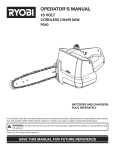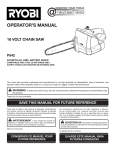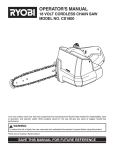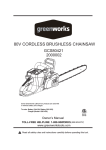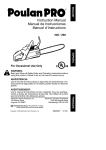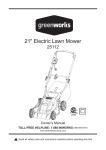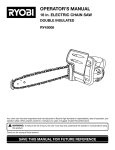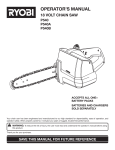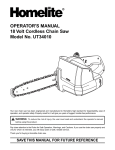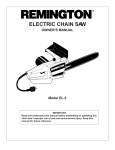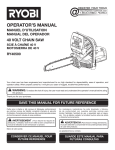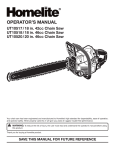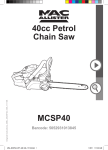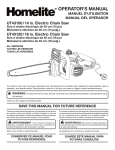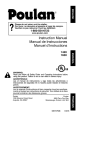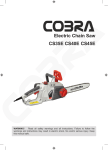Download 40V BRUSHLESS CHAINSAW
Transcript
40V BRUSHLESS CHAINSAW 20312 Some Greenworks Lithium-Ion products are sold with or without battery and charger. To order: Battery (4Ah 40V Battery 29472) Charger (Model # 29482) Owner’s Manual TOLL-FREE HELPLINE: 1-888-90WORKS (888.909.6757) Read all safety rules and instructions carefully before operating this tool. CONTENTS Contents .............................................................................................................................. 2 .......................................................................................................... 2 Safety information............................................................................................................. 3-7 Symbols ............................................................................................................................8-9 Know your chain saw ......................................................................................................... 10 Assembly ............................................................................................................................11 Operation ...................................................................................................................... 12-26 Maintenance .................................................................................................................27-35 Environmentally safe battery disposal ...............................................................................36 Troubleshooting .................................................................................................................37 Warranty ............................................................................................................................ 38 Exploded View ................................................................................................................... 39 Parts List............................................................................................................................ 40 Notes ................................................................................................................................. 41 PRODUCT SPECIFICATIONS 40V BRUSHLESS CHAINSAW Type....................................................................................... Cordless, battery-powered Motor ........................................................................................................................ 40 V Bar length .......................................................................................................16” (40 cm) Chain pitch ................................................................................................. 3/8” (9.5 mm) Chain gauge ............................................................................................0.043” (1.1 mm) Chain type ......................................................................................... 90PX056X(Oregon) Guide bar type .........................................................................16"164MLEA041 (Oregon) Unit weight ...................................................................................................10.36 lbs (4.7 kg) 10 YEAR/AÑO MOTOR WARRANTY GARANTÍA DE MOTOR 4 2 YEAR/AÑO YEAR/AÑO BATTERY WARRANTY GARANTÍA DE BATERÍA TOOL WARRANTY GARANTÍA DE INSTRUMENTO 2 SAFETY INFORMATION IMPORTANT SAFETY INSTRUCTIONS I M P O R TA N T READ AND UNDERSTAND ALL INSTRUCTIONS. Failure to follow all instructions listed below . • Do not start cutting until you have a clear work area, secure footing, and a planned retreat path from the falling tree. Cluttered areas invite accidents. • Keep all children, bystanders, visitors, and animals out of the work area while starting or cutting with the chain saw. • • liquids, gases, or dust. Power tools create sparks which may ignite the dust or fumes. cut resistant material or ones that contain cut resistant inserts. Wear non-slip safety footwear. Wear non-slip heavy duty gloves to improve your grip and to protect your hands. Do not wear be drawn into the motor or catch the chain or underbrush. Secure hair so it is above shoulder level. • Heavy protective clothing may increase operator fatigue, which could lead to heat stroke. During weather that is hot and humid, heavy work should be scheduled for early morning or late afternoon hours when temperatures are cooler. • Wear eye protection which is marked to comply with ANSI Z87.1 as well as hearing and head protection when operating this equipment. • Always be aware of what you are doing when using the chain saw. Use common sense. Do medication. • Do not expose the chain saw to rain. • Do not use the chain saw in damp or wet locations. • Stay alert and pay attention to what you are doing. Use common sense when using this unit. • Keep all parts of your body away from the saw chain when the unit is running. • Always carry the chain saw by the front handle with the battery removed and the guide bar and saw chain positioned to the rear. • Never let anyone use your chain saw who has not received adequate instructions in its proper use. This applies to rentals as well as privately owned saws. • Before you start the unit, make sure the saw chain is not contacting any object. • Stop the chain saw before setting it down. • • Maintain the unit with care. Keep the cutting edge sharp and clean for best performance and to reduce the risk of injury. Follow instructions for lubricating and changing accessories. • Keep handles dry, clean, and free of oil and grease. 3 SAFETY INFORMATION • the chain saw handles. Serious injury to the operator, helpers, bystanders, or any combination of these persons may result from one-handed operation. A chain saw is intended for twohanded use. • Avoid body contact with grounded surfaces such as metal pipes and wire fences. There is an increased risk of electric shock if your body is grounded. • Do not operate a chain saw that is damaged, improperly adjusted, or not completely and securely assembled. Chain should slow to a stop when the switch trigger is released. If the chain continues to turn after the switch trigger has been released, have the unit serviced by your nearest GREENWORKS service dealer. • Check for damaged parts. Check for alignment of moving parts, binding of moving parts, breakage of parts, mounting, and any other conditions that may affect its operation. A guard or other part that is damaged should be properly repaired or replaced by an authorized service dealer unless otherwise indicated elsewhere in this manual. • All chain saw service, other than the items listed in the operation and maintenance sections, should be performed by your nearest GREENWORKS service dealer. • Always maintain a proper stance. • Do not use chain saw if switch does not turn it on and off. Have defective switch replaced by authorized service centre. • Remove the battery when not in use, before servicing, and when making adjustments and changing attachments, such as saw chain and bar. • Do not cut vines and/or small underbrush. • Do not operate a chain saw in a tree, on a ladder, or scaffold; this is extremely dangerous. NOTE: The size of the work area depends on the job being performed as well as the size tree or work piece involved. For example, felling a tree requires a larger work area than making bucking cuts. • Use extreme caution when cutting small size brush and saplings, because small material may catch the saw chain and be whipped toward you or pull you off balance. • When cutting a limb that is under tension, be alert for spring back so that you will not be struck • Do not force the chain saw. The job can be performed better and safer at the rate for which it was intended. • Always use the right product for your application. The chain saw should be used for cutting wood only. Never use the chain saw to cut plastic, masonry or non-wood building materials. • Do not use the chain saw for purposes not intended. • Store chain saw when not in use. Chain saw should be stored in a dry and high or locked area out of the reach of children. • Save these instructions. Refer to them frequently and use them to instruct others who may use this tool. If you loan someone this tool, loan them these instructions also. 4 SAFETY INFORMATION WA R N I N G Some dust created by power sanding, sawing, grinding, drilling, and other construction activities contains chemicals known to cause cancer, birth defects or other reproductive harm. Some examples of these chemicals are: • lead from lead-based paints, • crystalline silica from bricks and cement and other masonry products, and • arsenic and chromium from chemically-treated lumber. Your risk from these exposures varies, depending on how often you do this type of work. To reduce your exposure to these chemicals: work in a well- ventilated area, and work with approved safety WA R N I N G ( P R O P O S I T I O N 6 5 ) Some dust created by power sanding, sawing, grinding, drilling and other construction activities contains chemicals known to the state of California to cause cancer, birth defects or other reproductive harm. Some examples of these chemicals are: • Lead from lead-based paints, • Crystalline silica from bricks and cement and other masonry products, and • Arsenic and chromium from chemically-treated lumber. Your risk from these exposures varies, depending on how often you do this type of work. To reduce your exposure to these chemical: work in a well ventilated area, and work with approved particles. 5 SAFETY INFORMATION KICKBACK (See Figure 1-2) WA R N I N G Kickback may occur when the moving chain contacts an object at the upper portion of the tip of the guide bar or when the wood closes in and pinches the saw chain in the cut. Contact at the upper portion of the tip of the guide bar can cause the chain to dig into the object and stop the chain for an instant. The result is a lightning fast, reverse reaction which kicks the guide bar up and back toward the operator. If the saw chain is pinched along the top of the guide bar, the guide bar can be driven rapidly back toward the operator. Either of these reactions can cause loss of saw control which can result in serious injury. Do not rely exclusively upon the safety devices built into the saw. As a chain saw user, you should take several steps to keep your cutting jobs free from accident or injury. 0 • The following precautions should be followed to minimize kickback: 1. unit is running. Place your right hand on the rear handle and your left hand on the front with a stiff left arm will help you maintain control of the saw if kickback occurs. 2. Make sure that the area in which you are cutting is free from obstructions. Do not let the nose of the guide bar contact a log, branch, fence, or any other obstruction that could be hit while you are operating the saw. 3. Always cut with the unit running. Fully squeeze the switch trigger and maintain cutting speed. 4. Use only the replacement guide bars and low kickback chains sp ecified by the manufacturer for the saw. • With a basic understanding of kickback, you can reduce or eliminate the element of surprise. Sudden surprise contributes to accidents. • Keep proper footing and balance at all times. • Do not cut above shoulder height or overreach when cutting. • Follow the sharpening and maintenance instructions for the saw chain. Rotational Kickback Fig. 1 Kickback Danger Zone Fig. 2 6 SAFETY INFORMATION • Push and Pull - This reaction force is always opposite to the direction the chain is moving where wood contact is made. Thus, the operator must be ready to control the PULL when cutting on the bottom edge of the bar, and PUSH when cutting along the top edge. (See Figure 3) PULL 0 PUSH Fig. 3 UNDERSTANDING YOUR CHAIN SAW SAFETY DEVICES (See Figure 4) Fig. 4 LOW KICKBACK SAW CHAIN The rakers (depth gauges) ahead of each cutter can minimize the force of a kickback reaction by preventing the cutters from digging in too deeply at the kickback zone. Only use replacement B175.1. Low kickback/skip tooth saw chain is a chain that has met the kickback performance requirements of ANSI B175.1 - 1991 (American National Standard for Power Tools - GasolinePowered Chain Saws-Safety Requirements) when tested on the representative sample of chain useful life, they lose some of the low kickback qualities and extra caution should be used. 7 SYMBOLS Some of the following symbols may be used on this product. Please study them and learn their meaning. Proper interpretation of these symbols will allow you to operate the product better and safer. SYMBOL NAME DESIGNATION/EXPLANATION V Volts Voltage A Amperes Current Hz Hertz Frequency (cycles per second) W Watts Power Minutes Time Alternating Current Type of current Direct Current Type or a characteristic of current No Load Speed Rational speed, at no load Class II Construction Double-insulated construction Per Minute Revolutions, strokes, surface speed, orbits etc., per minute Wet Conditions Alert Do not expose to rain or use in damp locations Read The Operator’s Manual To reduce the risk of injury user must read and understand operator’s manual before using this product. Eye and Head Protection Wear eye and head protection when operating this equipment. Safety Alert Precautions that involve your safety. Operate With Two Hands Hold and operate the saw properly with both hands Kickback DANGER! Beware of kickback. Bar Nose Contact Avoid bar nose contact. Wear Gloves Wear non-slip, heavy-duty protective gloves when handling the chainsaw. Wear Safety Footwear Wear non-slip safety footwear when using this equipment. Keep Bystanders Away Keep all bystanders at least 50 ft. away. min /min 8 SYMBOLS The following signal words and meanings are intended to explain the levels of risk associated with this product. SYMBOL SIGNAL MEANING DANGER Indicates an imminently hazardous situation, which, if not avoided, will result in death or serious injury. WARNING Indicates a potentially hazardous situation, which, if not avoided, could result in death or serious injury. CAUTION Indicates a potentially hazardous situation, which, if not avoided, may result in minor or moderate injury. CAUTION SERVICE 0 (Without Safety Alert Symbol) Indicates a situation that may result in property damage. Servicing requires extreme care and knowledge and should be performed only by a qualified service technician. For service we suggest you return the product to your nearest AUTHORIZED SERVICE CENTER for repair. When servicing, use only identical replacement parts. WA R N I N G To avoid serious personal injury, do not attempt to use this product until you have read this Owner's Manual thoroughly and understand it completely. If you do not understand the warnings and instructions in this Owner's Manual, do not use this product. Call the Toll-free Helpline (1888-909-6757) for assistance. WA R N I N G The operation of any power tool can result in foreign objects being thrown into your eyes, which can result in severe eye damage. Before beginning power tool operation, always wear safety goggles or safety glasses with side shields and, when needed, a full face shield. We recommend Wide Vision Safety Mask for use over eyeglasses or standard safety glasses with side shields. Always use eye protection which is marked to comply with ANSI Z87.1. SAVE THESE INSTRUCTIONS 9 KNOW YOUR CHAIN SAW Read this operator's manual and safety rules before operating your chain saw. Compare the illustration in Figure 5 to your chain saw in order to familiarize yourself with the location of various controls and adjustments. Save this manual for future reference. Scabbard On/Off Switch Switch Trigger Low Kickback Saw Chain Front Handle OIL RESERVOIR CAP Quick View Oil Indicator switch lock Front hand guard / Chain Brake Rear Handle Guide Bar Chain Cover Lock knob Chain Tension Chain Cover knob 10 Fig. 5 ASSEMBLY INSTRUCTIONS UNPACKING This product has been shipped completely assembled. • Carefully remove the product and any accessories from the box. Make sure that all items listed in the packing list are included. • Inspect the product carefully to make sure no breakage or damage occurred during shipping. • Do not discard the packing material until you have carefully inspected and satisfactorily operated the product. • If any parts are damaged or missing, please call 1-888-909-6757 for assistance. PACKING LIST • Chain saw • Scabbard • Owner's Manual • Black bag • Battery • Charger WA R N I N G If any parts are damaged or missing, do not operate this product until the parts are replaced. Failure to heed this warning could result in serious personal injury. WA R N I N G Do not attempt to modify this product or create accessories not recommended for use with this leading to possible serious personal injury. WA R N I N G insert starting and possible serious personal injury. 11 OPERATING YOUR CHAIN SAW WA R N I N G Do not allow familiarity with this product to make you careless. Remember that a careless WA R N I N G Always wear safety goggles or safety glasses with side shields that comply with ANSI Z87.1, when operating power tools. Failure to do so could result in objects being thrown into your eyes, resulting in possible serious injury. WA R N I N G Do not use any attachments or accessories not recommended by the manufacturer of this product. The use of attachments or accessories not recommended can result in serious personal injury. APPLICATIONS You may use this product for the purposes listed below: • Basic limbing, felling, and woodcutting • Removing buttress roots 12 OPERATING YOUR CHAIN SAW ADDING BAR AND CHAIN LUBRICANT (See Figure 6) Use Bar and Chain Lubricant. It is designed for chains and chain oilers, and is formulated to perform over a wide temperature range with no dilution required. NOTE: Chain saw comes from the factory with no bar and chain oil added. Level should also be checked after • Remove oil cap. • Carefully pour the bar and chain oil into the tank. • Wipe off excess oil. • • Repeat as needed. NOTE: Do not use dirty, used or otherwise contaminated oils. Damage may occur to the bar or chain. DO NOT re- move the foam. NOTE: It is normal for oil to seep from the saw when not in use. To prevent seepage, empty the oil tank after each use then run for one minute. When storing the unit for a long period of time (three months or longer) be sure the chain is lightly lubricated; this will prevent rust on the chain and bar sprocket. I M P O R TA N T To preserve natural resources, please recycle or dispose of oil properly. Consult your local waste authority for information regarding available recycling and/disposal options. Oil Reservoir Cap AIN C HANT IC R LUB Quick View Oil Indicator Fig. 6 13 OPERATING YOUR CHAIN SAW BATTERY PACK (See Figure 7) I M P O R TA N T The battery pack is not charged when it is purchased. Before using the chain saw for the first time, place the battery pack in the battery charger and charge it fully. Be sure to read all safety precautions, and follow the instructions in the section entitled Charging Procedure. With regular use, the battery will require shorter charging times. When storing the chain saw for a prolonged period of time, remove the battery. When the chain saw is going to be used again, charge the battery pack for at least a full charging period. This product has no memory effect. REMOVING THE BATTERY PACK 0 •Press the latch button (1) on the battery pack down and hold. •Grasp the chain saw (2) firmly, and pull the battery pack out of the handle. Note: The battery pack fits into the handle snugly in order to prevent accidental dislodging. It may require a strong pull to remove it. 14 OPERATING YOUR CHAIN SAW INSTALLING THE BATTERY PACK • Align the tongue (3) of the battery pack with the cavity. • • Push the battery pack into the handle until the latch locks into place. • Do not use force when inserting the battery pack. It should slide into position and “click”. WA R N I N G • Replace the battery pack or the charger immediately if the battery case or charger cord is damaged. • Verify that the switch is in the OFF position before inserting or removing the battery pack. • Verify that the battery pack is removed and the switch is in the OFF position before inspecting, adjusting, or performing maintenance on any part of the chain saw. • Read, understand, and follow the instructions contained in the section entitled Charging Procedure. I M P O R TA N T This Lithium-ion battery pack is equipped with an internal circuit breaker which will automatically shut off the power to the tool and then reset itself once cooled. Follow these steps if an overload occurs while under heavy use: 1. Release the power switch and restart tool by depressing switch. 2. The battery may need to be removed for approximately 1 minute, allowed to cool and then reinstalled for use. Fig. 7 1 3 2 STARTING AND STOPPING THE CHAIN SAW (See Figure 8) WA R N I N G Keep body to the left of the chain line. Never straddle the saw or chain, or lean over past the chain line. 15 OPERATING YOUR CHAIN SAW STARTING THE CHAIN SAW: • Make sure chain tension is at desired setting. Refer to Adjusting the Chain Tension in the Maintenance of this manual. • Make sure the chain cover lock bolt is tight to the chain cover. • Make sure no objects or obstructions are in immediate vicinity which could come in contact with the bar and chain. • Fit the battery pack into the chain saw (see figure 7). Note: If the Chain Saw makes a rapid beeping sound when attempting to start the saw, the chain brake is engaged. To start follow instructions above from the beginning. • Press and hold the on/off switch. This makes the switch trigger operational. • Press and hold the switch trigger, release the switch lock and continue to squeeze the switch trigger for continued operation. STOPPING THE CHAIN SAW: NOTE: It is normal for the chain to coast to a stop once the trigger switch is released. • Release the switch trigger to stop the chain saw. • Upon release of the switch trigger, the switch lock will be automatically reset to the lock position. OPERATING THE CHAIN BRAKE (See Figure 9) Check the operating condition of the chain brake prior to each use. • Engage the chain brake by rotating your left hand around the front handle, allowing the back of your hand to push the chain brake lever/hand guard toward the bar while the chain is rotating rapidly. Be sure to maintain both hands on the saw handles at all times. • Reset the chain brake back into the RUN posi¬tion by grasping the top of the chain brake lever/hand guard and pulling toward the front handle. WA R N I N G If the chain brake do not stop the chain immediately, or if the chain brake will not stay in the run position without assistance, take the saw to an authorized service center for repair prior to use. Fig. 8 BRAKE POSITION On/Off switch Fig. 9-1 RUN POSITION Switch Trigger Fig. 9-2 16 OPERATING YOUR CHAIN SAW PREPARING FOR CUTTING PROPER GRIP ON HANDLES (See Figure 9) See General Safety Rules for appropriate safety equipment. • Wear non-slip gloves for maximum grip and protection. • • right hand on the rear handle so that your body is to the left of the chain line. the handle and the thumb is wrapped under the handlebar. This grip is least likely to be broken are on the same side of the handle is dangerous because a slight kick of the saw can cause loss of control. WA R N I N G 0 Never use a left-handed (cross-handed) grip or any stance that would place your body or arm across the chain line. Fig. 9 WA R N I N G DO NOT operate the switch trigger with your left hand and hold the front handle with your right hand. Never allow any part of your body to be in the chain line while operating a saw. PROPER HAND GRIP POSITION CHAIN LINE Proper Grip IMPROPER GRIP 17 OPERATING YOUR CHAIN SAW PROPER CUTTING STANCE (See Figure 10) • Balance your weight with both feet on solid ground. • Keep left arm with elbow locked in a “straight arm” position to withstand any kickback force. • Keep your body to the left of the chain line. • Keep your thumb on underside of handlebar. THUMB ON UNDERSIDE OF HANDLE BAR Chain Line 0 18 Straight Arm Fig. 10 OPERATING YOUR CHAIN SAW BASIC OPERATING/CUTTING PROCEDURES Practice cutting a few small logs using the following technique to get the “feel” of using the saw before you begin a major sawing operation. •Take the proper stance in front of the wood with the saw idling. •Press the switch lock and squeeze the switch trigger then release switch lock and let the chain accelerate to full speed before entering the cut. •Begin cutting with the saw against the log. •Keep the unit running the entire time you are cutting, maintain a steady speed. •Allow the chain to cut for you; exert only light downward pressure. Forcing the cut could result in damage to the bar, chain, or motor. 0 •Release the switch trigger as soon as the cut is completed, allowing the chain to stop. If you run the saw without a cutting load, unnecessary wear can occur to the chain, bar, and unit. •Do not put pressure on the saw at the end of the cut. WORK AREA PRECAUTIONS (See Figure 11) •Cut only wood or materials made from wood; no sheet metal, no plastics, no masonry, no nonwood building materials. •Never allow children to operate the saw. Allow no person to use this chain saw who has not read this operator’s manual or received adequate instructions for the safe and proper use of this chain saw. •Keep everyone – helpers, bystanders, children, and animals – a SAFE DISTANCE from the cutting area. During felling operations, the safe distance should be a least twice the height of the largest trees in the felling area. During bucking operations, keep a minimum distance of 15' (4.6 m) between workers. •Always cut with both feet on solid ground to prevent being pulled off balance. •Do not cut above chest height as a saw held higher is difficult to control against kickback forces. •Do not fell trees near electrical wires or buildings. Leave this operation for professionals. •Cut only when visibility and light are adequate for you to see clearly. Fig. 11 19 OPERATING YOUR CHAIN SAW FELLING TREES HAZARDOUS CONDITIONS WA R N I N G Do not fell trees during periods of high wind or heavy precipitation. Wait until the hazardous weather has ended. When felling a tree, it is important that you heed the following warnings to prevent possible serious injury. • Do not cut down trees having an extreme lean or large trees with rotten limbs, loose bark, or hollow trunks. Have these trees pushed or dragged down with heavy equipment, then cut t hem up. • Do not cut trees near electrical wires or buildings. • Check the tree for damaged or dead branches that could fall and hit you during felling. • Periodically glance at the top of the tree during the backcut to assure the tree is going to fall in the desired direction. • If the tree starts to fall in the wrong direction, or if the saw gets caught or hung up during the fall, leave the saw and save yourself! Statements hall f ault protection low-v oltage protection ov ercurrent protection Blocking protection short circuit protection Abnormal communication MOS high temp. protection Abnormal battery temp Power on abnormal indicate brake LED indicate Solv e method Green light of f red light on; f lash 7 times; each time interv al: 3s; keep 60s, buzzer alarm Green light of f red light on; f lash 5 times; each time interv al: 3s; keep 60s, buzzer alarm Green light of f red light on; f lash 4 times; each time interv al: 3s; keep 60s, buzzer alarm Green light of f red light on; f lash 4 times; each time interv al: 3s; keep 60s, buzzer alarm Green light of f red light on; f lash 4 times; each time interv al: 3s; keep 60s, buzzer alarm Green light of f red light on; f lash 3 times; each time interv al: 3s; keep 60s, buzzer alarm Green light of f red light on; f lash 6 times; each time interv al: 3s; keep 60s, buzzer alarm Green light of f red light on; f lash 6 times; each time interv al: 3s; keep 60s, buzzer alarm Red light on green light on, buzzer alarm Red light on green light on, buzzer alarm 20 keep 1hz Release trigger keep 1hz Restart the power button keep 1hz Release trigger keep 1hz Release trigger keep 1hz Release trigger keep 1hz Restart the power button When the temp. is below keep 1hz 70 degree centigrade, the chain saw can run well When the temp. of the keep 1hz battery low down, the chain saw can run well Release trigger Return the guard and release the trigger OPERATING YOUR CHAIN SAW PROPER PROCEDURE FOR TREE FELLING (See Figure 12-15) •Felling a tree — When bucking and felling operations are being performed by two or more persons, at the same time, the felling operation should be separated from the bucking operation by a distance of at least twice the height of the tree being felled. Trees should not be felled in a manner that would endanger any person, strike any utility line or cause any property damage. If the tree does make contact with any utility line, the utility company should be notified immediately. •Operator should keep on the uphill side of terrain as the tree is likely to roll or slide after it is felled. •Pick your escape route (or routes in case the intended route is blocked). Clear the immediate area around the tree and make sure there are no obstructions in your planned path of retreat. Clear the path of safe retreat approximately 135° from the planned line of fall. 0 •Consider the force and direction of the wind, the lean and balance of the tree, and the location of large limbs. These things influence the direction in which the tree will fall. Do not try to fell a tree along a line different from its natural line of fall. •Remove dirt, stones, loose bark, nails, staples, and wire from the tree where felling cuts are to be made. •Notched Undercut. Cut a notch about 1/3 the diameter of the trunk in the side of the tree. Make the notch cuts so they intersect at a right angle to the line of fall. This notch should be cleaned out to leave a straight line. To keep the weight of the wood off the saw, always make the lower cut of the notch before the upper cut. •Felling Backcut. As the felling cut gets close to the hinge the tree should begin to fall. If there is any chance the tree may not fall in the desired direction or it may rock back and bind the saw chain, stop cutting before the felling cut is complete and use wedges of wood, plastic or aluminum to open the cut and drop the tree along its desired line of fall. Make the backcut level and horizontal, and at a minimum of 2" (5 cm) above the horizontal cut of the notch. PLANNED LINE OF FALL PLANNED LINE OF FALL 90° 135° FROM PLANNED LINE OF FALL 135° 45° PATH OF SAFE RETREAT 90° 45° 135° PATH OF SAFE RETREAT Fig. 12 21 OPERATING YOUR CHAIN SAW NOTE: Never cut through to the notch. Always leave a band of wood between the notch and back cut (approximately 2" (5 cm) or 1/10 the diameter of the tree). This is called “hinge” or “hingewood.” It controls the fall of the tree and prevents slipping or twisting or shoot back of the tree off the stump. •On large diameter trees, stop the back cut before it is deep enough for the tree to either fall or settle back on the stump. Then insert soft wooden or plastic wedges into the cut so they do not touch the chain. Drive wedges in, little by little, to help jack the tree over. •As tree starts to fall, stop the chain saw and put it down immediately. Retreat along the cleared path, but watch the action in case something falls your way. 0 HINGE 2" (5 cm) OR 1/10 DIA Back Cut Hinge NOTCH APPROX. 1/3 DIAMETER OF TRUNK BACK CUT 2" (5 cm) Fig. 13 Fig. 14 Fig. 15 Wedge 22 OPERATING YOUR CHAIN SAW REMOVING BUTTRESS ROOTS (See Figure 16) A buttress root is a large root extending from the trunk of the tree above the ground. Remove vertical cut. Remove the resulting loose section from the work area. Follow the correct tree felling procedure as stated in Proper Procedure For Tree Felling after you have removed the large buttress roots. BUCKING (See Figure 17) Bucking is the term used for cutting a fallen tree to the desired log length. • Always make sure your footing is secure and your weight is distributed evenly on both feet. • Cut only one log at a time. 0 • Support small logs on a saw horse or another log while bucking. • Keep a clear cutting area. Make sure that no objects can contact the guide bar nose and chain during cutting, this can cause kickback. Refer to Kickback earlier in this manual. • When bucking on a slope, always stand on the uphill side of the log. To maintain complete control of the chain saw when cutting through the log, release the cutting pressure near the end of the cut without relaxing your grip on the chain saw handles. Do not let the chain contact the ground. After completing the cut, wait for the saw chain to stop before you move the chain saw. Always stop the motor before moving from tree to tree. KICKBACK Vertical Cut Loose Section Horizontal Cut Fig. 16 Fig. 17 23 OPERATING YOUR CHAIN SAW BUCKING WITH A WEDGE (See Figure 19) If the wood diameter is large enough for you to insert a soft bucking wedge without touching the chain, you should use the wedge to hold the cut open to prevent pinching. BUCKING LOGS UNDER STRESS (See Figure 20) side. As you cut the log, it will tend to bend. The saw can become pinched or hung in the log if under stress to prevent the bar and chain from pinching. OVERBUCKING (See Figure 21) Begin on the top side of the log with the bottom of the saw against the log; exert light pressure downward. Note that the saw will tend to pull away from you. UNDERBUCKING (See Figure 22) Begin on the under side of the log with the top of the saw against the log; exert light pressure upward. During under bucking, the saw will tend to push back at you. Be prepared for this LOG SUPPORTED AT ONE END LOAD FINISHING CUT 1ST CUT 1/3 DIA LOG SUPPORTED AT BOTH ENDS LOAD 1ST CUT 1/3 DIA Fig. 19 OVERBUCKING Fig. 21 FINISHING CUT UNDERBUCKING 24 Fig. 20 Fig. 22 OPERATING YOUR CHAIN SAW LIMBING (See Figure 22) Limbing is removing branches from a fallen tree. •Work slowly, keeping both hands on the chain saw with a firm grip. Always make sure your footing is secure and your weight is distributed evenly on both feet. •Leave the larger support limbs under the tree to keep the tree off the ground while cutting. •Limbs should be cut one at a time. Remove the cut limbs from the work area often to help keep the work area clean and safe. •Branches under tension should be cut from the bottom up to avoid binding the chain saw. •Keep the tree between you and the chain saw while limbing. Cut from the side of the tree opposite the branch you are cutting. PRUNING (See Figure 23) 0 Pruning is trimming limbs from a live tree. •Work slowly, keeping both hands on the chain saw with a firm grip. Always make sure your footing is secure and your weight is distributed evenly on both feet. •Do not cut from a ladder, this is extremely dangerous. Leave this operation for professionals. •Do not cut above chest height as a saw held higher is difficult to control against kickback. •When pruning trees it is important not to make the finishing cut next to the main limb or trunk until you have cut off the limb further out to reduce the weight. This prevents stripping the bark from the main member. •Underbuck the branch 1/3 through for your first cut. •Your second cut should overbuck to drop the branch off. •Now make your finishing cut smoothly and neatly against the main member so the bark will grow back to seal the wound. WA R N I N G If the limbs to be pruned are above chest height, hire a professional to perform the pruning. LOAD Second Cut First Cut 1/3 Diameter Finishing Cut CUT LIMBS ONE AT A TIME AND LEAVE SUPPORT LIMBS UNDER TREE UNTIL LOG IS CUT Fig. 22 Fig. 23 25 OPERATING YOUR CHAIN SAW CUTTING SPRINGPOLES (See Figure 24) A springpole is any log, branch, rooted stump, or sapling which is bent under tension by other wood so that it springs back if the wood holding it is cut or removed. On a fallen tree, a rooted stump has a high potential of springing back to the upright position during the bucking cut to separate the log from the stump. Watch out for springpoles — they are dangerous. WA R N I N G Springpoles are dangerous and could strike the operator, causing the operator to lose control of the chain saw. This could result in severe or fatal injury to the operator. 0 SPRINGPOLE 26 Fig. 24 MAINTENANCE WA R N I N G When servicing, use only identical replacement parts. Use of any other parts may create a hazard or cause product damage. WA R N I N G Always wear safety goggles or safety glasses with side shields during power tool operation or when blowing dust. If operation is dusty, also wear a dust mask. GENERAL MAINTENANCE 0 Avoid using solvents when cleaning plastic parts. Most plastics are susceptible to damage from various types of commercial solvents and may be damaged by their use. Use clean cloths to WA R N I N G come in contact with plastic parts. Chemicals can damage, weaken, or destroy plastic, which may result in serious personal injury. LUBRICATION for the life of the unit under normal operating conditions. Therefore, no further lubrication is required. REPLACING THE GUIDE BAR AND CHAIN (See Figure 27-33) D A N G E R Never start the motor before installing the guide bar, chain, chain cover, and chain cover lock possible serious injury. WA R N I N G To avoid serious personal injury, read and understand all the safety instructions in this section. WA R N I N G Before performing any maintenance, make sure the battery is removed. Failure to heed this warning could result in serious personal injury. 27 MAINTENANCE C A U T I O N Always wear gloves when handling the bar and chain; these components are sharp and may contain burrs. WA R N I N G Never touch or adjust the chain while the motor is running. The saw chain is very sharp; always wear protective gloves when performing maintenance to the chain to avoid possible serious lacerations. 0 Chain Combinations section later in this manual. • Remove the battery from the chain saw. • Rotate the chain cover lock bolt counterclockwise and remove knob and sleeve . • Remove the chain cover. • Remove the bar and chain from the mounting surface. • Remove the old chain from the bar. • Lay out the new saw chain in a loop and straighten any kinks. The cutters should face in the direction of chain rotation. If they face backwards, turn the loop over. • Place the chain drive links into the bar groove as shown. Chain Cover Lock Bolt Chain Tension Knob Fig. 27 Fig. 28 Mounting Surface BAR Chain Chain Cover 28 Fig. 29 MAINTENANCE NOTE: Make certain of direction of chain. • Position the chain so there is a loop at the back of the bar. • Hold the chain in position on the bar and place the loop around the sprocket. • bar. NOTE: When placing the bar on the bar studs, ensure that the adjusting pin is in the chain tension pin hole. • Replace the chain cover. • Replace the sleeve and chain cover lock bolt; use a hexagon ring spanner to rotate bolt clockwise to tension. The bar should still be free to move for tension adjustment. 0 • Remove all slack from the chain by turning the chain tensioning bolt clockwise with a hexagon ring spanner until the chain seats snugly against the bar with the drive links in the bar groove. • Lift the tip of the guide bar up to check for sag. • Release the tip of the guide bar and turn the chain tensioning bolt 1/2 turn clockwise. Repeat this process until sag does not exist. • Hold the tip of the guide bar up and tighten the chain cover lock bolt. The chain is correctly tensioned when there is no sag on the underside of the guide bar, the chain is snug, but it can be turned by hand without binding. NOTE: If chain is too tight, it will not rotate. Loosen the chain cover lock bolt slightly and turn the chain tensioning bolt 1/4 turn counterclockwise. Lift the tip of the guide bar up and retighten the chain cover lock bolt. Ensure that the chain will rotate without binding. Cutters Chain Rotation Chain Drive Links Bar Groove Chain Drive Links Fig. 30 Fig. 31 Fig. 32 Fig. 33 29 MAINTENANCE ADJUSTING THE CHAIN TENSIO (See Figure 34-35) WA R N I N G Never touch or adjust the chain while the motor is running. The saw chain is very sharp. Always wear protective gloves when performing maintenance on the chain. • Stop the motor and remove the battery from the chain saw before setting the chain tension. • Slightly loosen the chain cover lock bolt. • Turn the chain tensioning bolt clockwise to tension the chain. 0 NOTE: A cold chain is correctly tensioned when there is no slack on the underside of the guide bar, the chain is snug, and it can be turned by hand without binding. • on the drive links hang out of the bar groove. NOTE: During normal saw operation, the temperature of the chain increases. The drive links of a correctly tensioned warm chain will hang approximately 1/16" (1.3 mm) out of the bar groove. NOTE: New chains tend to stretch; check the chain tension frequently and tension as required. C A U T I O N A chain tensioned while warm may be too tight upon cooling. Check the “cold tension” before next use. Flats On Drive Links ≈ 1/16" (1.3 mm) Fig. 34 Fig. 35 30 MAINTENANCE CHAIN MAINTENANCE (See Figure 36 Use only a low-kickback chain on this saw. This fast-cutting chain provides kickback reduction when properly maintained. For smooth and fast cutting, maintain the chain properly. The chain requires sharpening when the wood chips are small and powdery, the chain must be forced through the wood during cutting, or the chain cuts to one side. During maintenance of the chain, consider the following: • • Raker (depth gauge) clearance. • Too low increases the potential for kickback. 0 • Not low enough decreases cutting ability. • If the cutter teeth hit hard objects such as nails and stones, or are abraded by mud or sand on the wood, have an authorized service center sharpen the chain. NOTE: Inspect the drive sprocket for wear or damage when replacing the chain. If signs of wear or damage are present in the areas indicated, have the drive sprocket replaced by an authorized service center. NOTE: If you do not fully understand the correct procedure for sharpening the chain after reading the instructions that follow, have the saw chain sharpened by an authorized service centre or replace with a recommended low-kickback chain. Raker (Depth Gauge) Clearance 1/32" (0.6 mm) 31 Fig. 36 MAINTENANCE SHARPENING THE CUTTERS (See Figure 37-40) obtained only when all cutters are uniform. C A U T I O N Make sure the battery is removed from the chain saw before you work on the saw. WA R N I N G The saw chain is very sharp. Always wear protective gloves when performing maintenance to the chain to prevent serious personal injury. 0 • Tension the chain prior to sharpening. Refer to Adjusting The Chain Tension. • bar. • • • • • C A U T I O N A dull or improperly sharpened chain can cause excessive motor speed during cutting, which may result in severe motor damage. WA R N I N G Improper chain sharpening increases the potential of kickback. WA R N I N G Failure to replace or repair a damaged chain can cause serious injury. 32 MAINTENANCE PARTS OF A CUTTER Cutting Corner Side Plate Top Plate Depth Gauge Rivet Hole Heel Toe Gullet Fig. 37 Fig. 38 0 Left Hand Cutters Right Hand Cutters Fig. 39 Fig. 40 TOP PLATE FILING ANGLE (See Figure 41) • CORRECT 30° – file holders are marked with guide marks to align file properly to produce correct top plate angle. • LESS THAN 30° – for cross cutting. • MORE THAN 30° – feathered edge dulls quickly. TOP PLATE FILING ANGLE 30° LESS THAN 30° MORE THAN 30° SIDE PLATE FILING ANGLE 80° CORRECT INCORRECT 33 Fig. 41 MAINTENANCE SIDE PLATE ANGLE (See Figure 42) • • HOOK – “Grabs” and dulls quickly; increases the potential of KICKBACK. Results from using a • BACKWARD SLOPE – Needs too much feed pressure; causes excessive wear to the bar and SIDE PLATE ANGLE (See Figure 43-45) • Maintain the depth gauge at a clearance of 1/32" (0.6 mm) Use a depth gauge tool for checking the depth gauge clearances. • • 0 depth gauge jointer. After lowering each depth gauge, restore original shape by rounding the • • HOOK BACKWARD SLOPE INCORRECT Fig. 42 Raker (Depth Gauge) Clearance 1/32" (0.6 mm) Fig. 43 Depth Gauge Jointer Restore Original Shape By Rounding The Front Flat File Fig. 44 34 Fig. 45 MAINTENANCE MAINTAINING THE GUIDE BAR (See Figure 46) Every week of use, reverse the guide bar on the saw to distribute the wear for maximum bar life. The bar should be cleaned every day of use and checked for wear and damage. Feathering or burring of the bar rails is a normal process of bar wear. Such faults should be smoothed with a file as soon as they occur. A bar with any of the following faults should be replaced: • Wear inside the bar rails that permits the chain to lay over sideways • Bent guide bar • Cracked or broken rails • Spread rails 0 Lubricate guide bars weekly with a sprocket at their tip. Using a grease syringe, lubricate weekly in the lubricating hole. Turn the guide bar and check that the lubrication holes and chain groove are free from impurities. Lubricating Hole Fig. 46 35 ENVIRONMENTALLY SAFE BATTERY DISPOSAL Li-Ion The batteries used in this pole saw's battery pack contain the following toxic and corrosive material: LITHIUM-ION. WA R N I N G 0 of the environment. Before disposing of damaged or worn out Lithium-Ion battery packs, contact your local waste disposal agency or the local Environmental Protection Agency for information and specific instructions. Take the batteries to a local recycling and/or disposal not, do not recharge it and do not use it. Dispose of it and replace it with a new battery pack. DO NOT ATTEMPT TO REPAIR IT! and to avoid damage to the environment: • Cover the battery's terminals with heavy-duty adhesive tape. • Do not attempt to remove or destroy any of the components of the battery pack. • Do not attempt to open the battery pack. • If a leak develops, the electrolytes that are released are corrosive and toxic. Do not get the solution in the eyes or on the skin, and do not swallow it. • Do not place batteries in regular household trash. • DO NOT incinerate batteries. • • waste stream. 36 TROUBLESHOOTING PROBLEM POSSIBLE CAUSE SOLUTION Bar and chain running hot and smoking. Check chain tension for overtightened condition. Tension chain. Refer to Chain Tension earlier in this manual. Chain oil tank empty. Check oil tank. Motor runs, but Chain tension too tight. chain is not rotating. Retention chain. Refer to Chain Tension earlier in this manual. Check guide bar and chain assembly. Refer to Replacing the Bar and Chain earlier in this manual. Check guide bar and chain for damage. Inspect guide bar and chain for damage. Motor runs, chain Dull chain. rotates but does not cut. Chain on backwards. Beep sound is heard while attempting to start. Sharpen chain. Reverse direction of chain. Chain Brake is engaged Refer to Starting Instructions 37 LIMITED FOUR-YEAR WARRANTY 10 YEAR/AÑO MOTOR WARRANTY GARANTÍA DE MOTOR 4 YEAR/AÑO TOOL WARRANTY GARANTÍA DE INSTRUMENTO 2 YEAR/AÑO BATTERY WARRANTY GARANTÍA DE BATERÍA GREENWORKS™ hereby warranties this product, to the original purchaser with proof of purchase, for a period of four (4) years against defects in materials, parts or workmanship. GREENWORKS™, at its own discretion will repair or replace any and all parts found to be defective, through normal use, free of charge to the customer. This warranty is valid only for units which have been used for personal use that have not been hired or rented for industrial/ commercial use, and that have been maintained in accordance with the instructions in the owners’ manual supplied with the product from new. Battery carries a two (2) year warranty against defects in workmanship and materials. Batteries must be charged in accordance with the operator’s manuals directions and regulations in order to be valid. Brushless Motor: Lifetime to original purchaser ITEMS NOT COVERED BY WARRANTY: 1. Any part that has become inoperative due to misuse, commercial use, abuse, neglect, accident, improper maintenance, or alteration; or 2. The unit, if it has not been operated and/or maintained in accordance with the owner's manual; or 3. Normal wear, except as noted below; 4. Routine maintenance items such as lubricants, blade sharpening; 5. GREENWORKS HELPLINE (1 888 90WORKS): Warranty service is available by calling our toll-free helpline, 9 a.m. to 5 p.m. EST. Monday – Friday at 1 888 909 6757 (1 888 90WORKS). TRANSPORTATION CHARGES: Transportation charges for the movement of any power equipment unit or attachment are the responsibility of the purchaser. It is the purchaser’s responsibility to pay transportation charges for any part submitted for replacement under this warranty unless such return is requested in writing by GREENWORKS. 38 EXPLODED VIEW 39 PARTS LIST Item No . 1 2 3 4 5 6 7 8 9 10 11 12 13 14 15 16 17 18 19 20 21 22 23 24 25 26 27 28 29 30 31 32 33 34 35 36 37 38 39 40 41 Par t No. 31101590 31100590 32206590 34108583 32212590 34108420 33904159 32200590 33302590 32209590 33304590 33902102 34111590 32104154 33204590 33203590 33206590 32104590 32202590 33100590 34900590 33101590 34110590 36101590 33202590 33224590 32207590 36302590 36301590 34105590 34103590 32211590 32206590 32204590 34113590 33200590 34109590 34106976 34108590 34106590 33207590 Des cr iption Saw chain Chain bar Screw ST4.8*14 Tension knob Screw ST3.5*8 Clamp Tension gear Tension bar Chain tension screw Ring Washer Sproket Insulate tube Bearing Output shaft Gear Bearing w asher Bearing Screw M5*8 Gear box housing Oil pump Gear box cover Air outlet guide circule Brushless motor Gear Torsion spring Brake shaft Sw itch 3 Sw itch 2 Guard Auxiliary handle Screw ST4.8*30 T25 Screw ST4.8*14 T25 Screw M6*12 Top cover Battery spring Battery left housing Battery insert Battery right housing Lock-off button Spring 40 QTY 1 1 1 1 2 1 1 1 1 1 1 1 1 1 1 1 1 1 1 1 1 1 1 1 1 1 1 1 1 1 1 2 14 2 1 1 1 1 1 1 1 PARTS LIST 42 43 44 45 46 47 48 49 50 51 52 53 54 55 56 57 58 59 60 61 62 63 64 65 66 67 68 69 70 71 72 73 74 75 76 77 78 79 341151607 34205154A 342011607 34112590 341111607 36201590 36300590 36202590 34115590 34200590 32203590 32201147 33304404 34114590 34116590 34201590 32210590 33300590 32205590 34206590 32900583 34102590 34129583-2 34217590 32227590 3420740A 30302271 3419650-1 36510154 30501281 3650339 33217590 32226590 32217301A 33203505-1 32218590 30301590 34903590 Oil tank cap Oil tank seal ring Oil tank inlet valve Oil tank Oil tank cord PCB board Sw itch 1 Pow er start board Sw itch trigger Oil inlet tube Nut Screw ST3*8 Brake spring Left housing Right housing Oil outlet tube Screw M6*16 Spikes Screw ST4.2*10 Washer Steel cable baffle ring Sproket cover Sproket cover tighten knob Log chips block Screw ST3*8 Tube Wire Terminal sleeve Terminal Wire B terminal Spring Screw M3*10 Screw ST2.9*8 Screw M4*10 Screw 2mm tube Pad 41 1 1 1 1 1 1 1 1 1 1 2 2 1 1 1 1 3 1 3 1 1 1 1 1 2 4 18 4 4 50 2 1 2 2 5 2 4 1 TOLL-FREE HELPLINE: 1-888-90WORKS (888.909.6757) Rev: 00 (06-18-13) Printed in China on 100% Recycled Paper










































